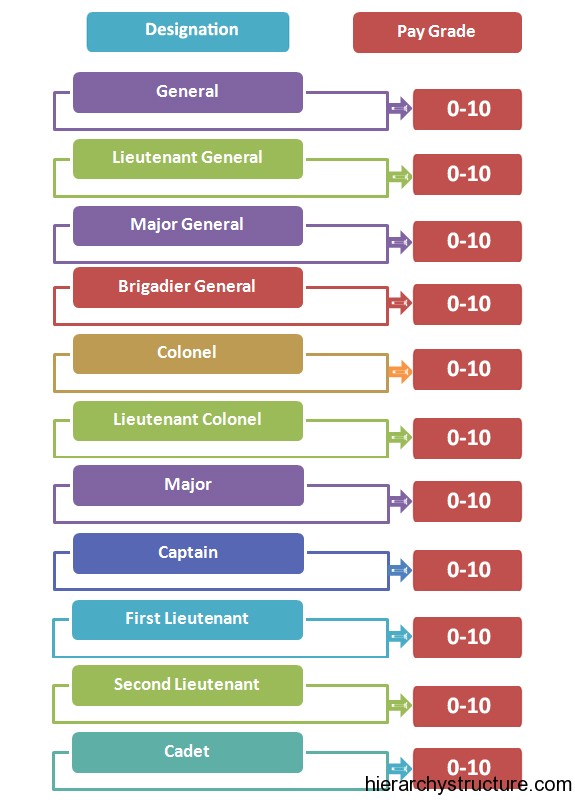The military hierarchy is a structured chain of command that plays a crucial role in ensuring efficiency, discipline, and organization within armed forces. This hierarchical system is not just a formal structure; it is essential for maintaining order, facilitating communication, and achieving strategic objectives in military operations. Understanding the nuances of military hierarchy can provide insight into how armed forces operate and function effectively.
In this article, we will delve deep into the various levels of military hierarchy, the roles and responsibilities associated with each rank, and how this hierarchy impacts military operations. Whether you are a military enthusiast, a student of defense studies, or simply curious about military structure, this guide aims to provide you with comprehensive knowledge of military hierarchy.
From the enlisted personnel to high-ranking officers, each level of military hierarchy has its significance and unique characteristics. By exploring this topic, we hope to illuminate the importance of military hierarchy not only in terms of rank but also in fostering leadership, cohesion, and strategic execution within military operations.
Table of Contents
- What is Military Hierarchy?
- Importance of Military Hierarchy
- Levels of Military Hierarchy
- Roles and Responsibilities in Military Hierarchy
- Military Hierarchy Across Different Countries
- Challenges in Military Hierarchy
- The Future of Military Hierarchy
- Conclusion
What is Military Hierarchy?
Military hierarchy refers to the organized structure within the armed forces that defines the roles, responsibilities, and authority of various ranks. This system is essential for maintaining order and ensuring that commands are executed efficiently. The hierarchy typically consists of multiple levels, starting from enlisted personnel to high-ranking officers, each with specific duties and authority.
Importance of Military Hierarchy
The military hierarchy is of paramount importance for several reasons:
- Efficiency: It ensures efficient decision-making and command execution.
- Discipline: The chain of command enforces discipline among personnel.
- Clear Communication: Facilitates clear communication channels within the military.
- Leadership Development: Promotes leadership skills as individuals advance through ranks.
Levels of Military Hierarchy
Enlisted Ranks
Enlisted personnel are the backbone of the military. They perform essential tasks and operations, often going through rigorous training to develop their skills. The ranks may vary between different branches, but generally include:
- Private
- Corporal
- Sergeant
- Staff Sergeant
Officer Ranks
Officers are responsible for leading enlisted personnel and managing operations. They typically hold a college degree and undergo specialized training. Common officer ranks include:
- Lieutenant
- Captain
- Major
- Colonel
General Officers
General officers hold the highest ranks in the military and are responsible for significant strategic decisions. These ranks include:
- Brigadier General
- Major General
- Lieutenant General
- General
Roles and Responsibilities in Military Hierarchy
Each level of military hierarchy comes with distinct roles and responsibilities. Understanding these can help clarify how military operations function:
- Enlisted Personnel: Execute tasks and implement orders from higher-ups.
- Officers: Plan, lead missions, and manage troops.
- General Officers: Formulate strategy and make high-level decisions affecting military operations.
Military Hierarchy Across Different Countries
While the concept of military hierarchy is universal, the specific ranks and structure can vary significantly across nations. For example:
- United States: The U.S. military has a well-defined hierarchy, with clear distinctions between enlisted and officer ranks.
- United Kingdom: The British Army uses similar ranks but has unique terminologies such as "Sergeant Major."
- Russia: The Russian military hierarchy includes ranks such as "General of the Army" which differs from Western structures.
Challenges in Military Hierarchy
Despite its importance, military hierarchy faces several challenges:
- Bureaucracy: Excessive layers of command can slow down decision-making.
- Communication Barriers: Miscommunication can occur, especially in high-pressure situations.
- Resistance to Change: Established hierarchies can resist modernization or adaptation to new tactics.
The Future of Military Hierarchy
As military operations evolve with technology and changing warfare tactics, the military hierarchy is also expected to adapt. Future trends may include:
- Increased emphasis on teamwork and collaboration across ranks.
- Integration of technology for better communication and decision-making.
- Flexibility in rank structures to adapt to modern warfare.
Conclusion
In summary, understanding military hierarchy is crucial for comprehending how armed forces operate effectively. From enlisted personnel to high-ranking officers, each level plays a vital role in maintaining order and achieving strategic objectives. As the military continues to evolve, so too will its hierarchical structures, adapting to meet the challenges of modern warfare.
We encourage you to leave your thoughts in the comments below, share this article with others who may find it informative, or explore more articles on our site for a deeper understanding of military operations.
Thank you for reading, and we hope to see you back here for more insightful content on military topics!
Gilbert Arenas: A Look Into His Children And Family Life
Spencer Paysinger: The Inspiring Journey Of An NFL Player
Understanding Zodiac Dates: A Comprehensive Guide To The Zodiac Signs


